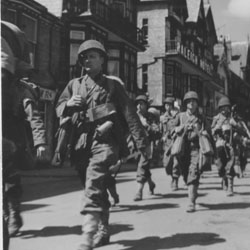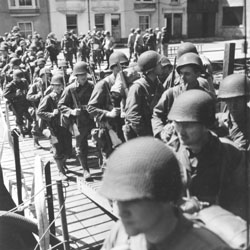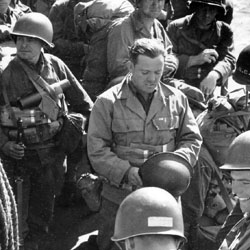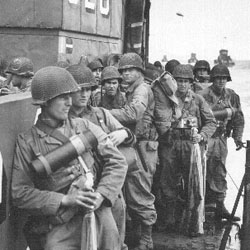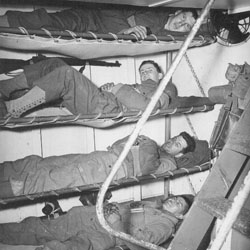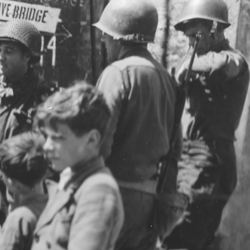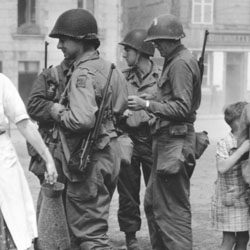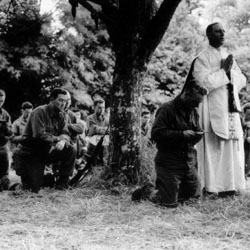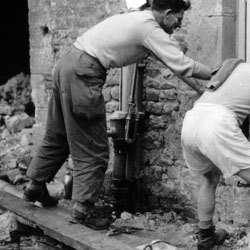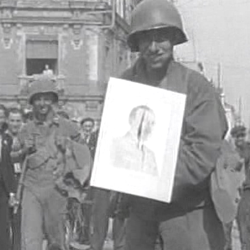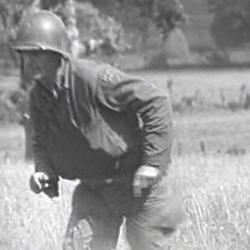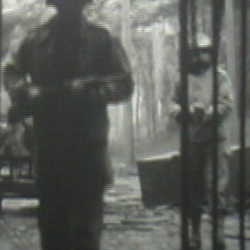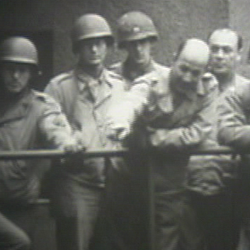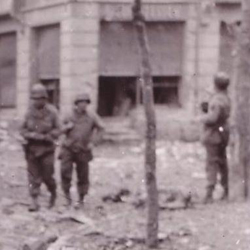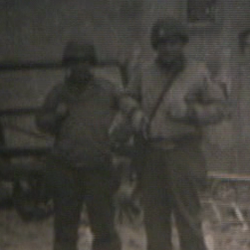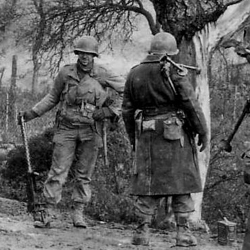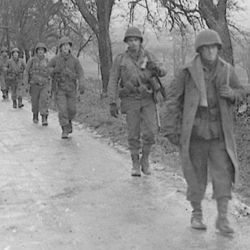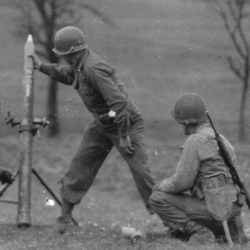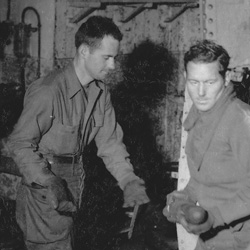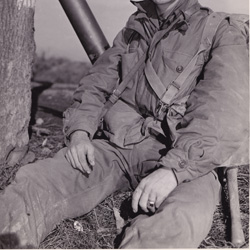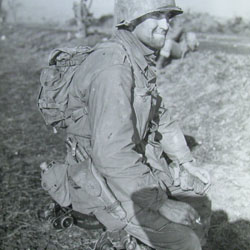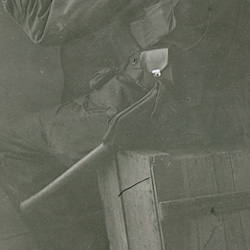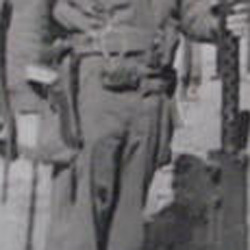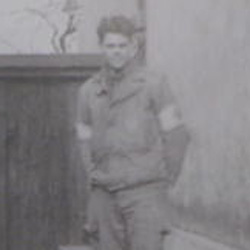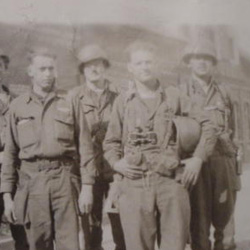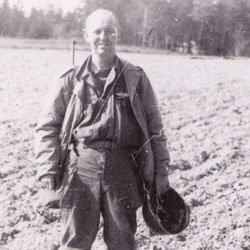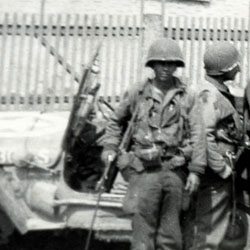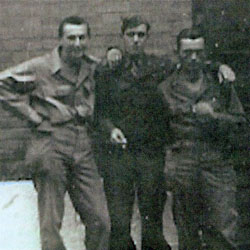Introduction:
Herringbone twill uniforms have a bad reputation in the WWII Reenacting hobby. Over the years, the cotton fatigue uniform has become synonymous with "Farb" and "HBT Commandos", where individuals and units with low authenticity targets wear HBT's alone as their primary uniform with modern sunglasses, brown t-shirts and marginal hightop boots. Furthermore, these uniforms are frequently patched up with divisional insignia and rank.
Many well intentioned reenactors have mentally associated HBT's with farbiness. "Statements of fact" and prevailing attitudes amongst many reenactors deem HBT's to be only acceptable for "Normandy impressions", with no rank or insignia applied to the uniform. Any wear or use outside of a "Normandy impression" is simply a farby cop out to not wear wool.
Great irony is exhibited on several reenactor forums, where the incontrovertible pontification of "research your unit" is thrown about; only to be followed with unsubstantiated lore.
I have focused singularly upon the 90th Division, for the entirety of their combat engagement in the ETO for this article.
Sources:
Division operations orders, supply documents and photographs are provided to illustrate the use of HBT uniforms by the 90th. Historical context is provided through the author's commentary and quotations from the Divisional After Action Reports.
A note on the G4 Report of Operations -
The G4 (Supply) Report of Operations is an appendix to the monthly Division level After Action Report. This official document contains granular data on the supplies, rations, gasoline, uniforms, and ammunition used during the month.
June 1944:
For Operation Neptune, as a part of VII Corps, the 90th landed on Utah Beach from June 6 - 10.
As part of their engagement in the run up to Operation Neptune, the Division received an issue of impregnated fatigues.
June 2, 1944 - Loading the LCI
Page 4 of the Neptune Operation Order for the 90th outlines recognition measures, specifically "Shoulder patches will be worn on impregnated fatigue jackets"

These uniforms are evidenced for both the rehearsals as well as the landing itself. Furthermore, in several photos rank is also applied to the fatigues.
359th RCT (Group A) Aboard LCI 326
While there certainly is no doubt that many units, the 90th included, went ashore with HBT's, it is interesting to observe the occasional combination of rank and insignia on the fatigues. Furthermore, it also appears that the impregnated fatigues were not immediately "ditched" upon coming ashore as is proclaimed by some undead historians.
The Division was at full strength and fresh issue of uniforms and equipment - except for the small wrinkle with the Susan B. Anthony hitting a mine and sinking.

July 1944:
July saw the 90th savage its way westward across the Contenin Peninsula towards Periers, grinding both itself and its enemy down in the hedgerows, Hill 122 and the Foret de Mont Castre.
During this time, the division had a steady stream of replacements coming forward, as well as a "complete change of clothing" inclusive of fatigues.

The month ended on a sour note for the 90th with the fiasco at Seves Island. Photos of 90th POW's from Seves Island illustrate how many of the men of the division were clothed.
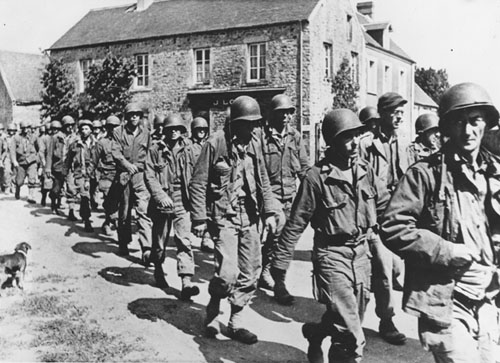
August 1944:
After the fiasco at Seves Island, Operation Cobra followed quickly, beginning the breakout, race to Le Mans and "Valley of Death" at Falaise.
The 90th charged to meet the Poles to close the Falaise Gap. Artillery played a decisive role in inflicting heavy casualties and forcing the collapse of the forces trapped in the encirclement.
Advances of 20-25 miles per day were not uncommon during August. Supply lines grew long, with priority being given to Class 1 and 3 supplies.
The month ended with a 225 mile movement from closing the gap to the outskirts of Reims.

September 1944:
The 90th continued its advance across france, passing through Maginot Line fortifications, ending the month on the outskirts of Metz, aiming to establish a bridgehead on the Moselle at Thionville.
During this time, supplies were prioritized to the whims of Bernard Montgomery...

October 1944:
The drive across France into Germany had stalled.
The month of October was spent around the fortress city of Metz.
Observation points were set up, aggressive patrolling was conducted .
Significant street fighting experience was gained at MAIZIERES-LES METZ. The city was used as a training ground for platoon and company level elements.
Units were rotated off the line for rest and rehabilitation. During this time, uniforms were refreshed and further preparations were made for the onset of cold weather.


November 1944:
The Moselle river at historic flood stage, swollen to 2400 feet wide from its normal 350 foot width, raging between the 90th and its part in assaulting the ring of fortresses around Metz. The rain continued to fall as a crossing was made in the shadow of Fort Koenigsmacker.
Within 11 days, Fort Koenigsmacker and the surrounding area had fallen to the 90th, completing the encirclement of Metz by the 5th, 90th, and 95th.
From November 20-24 the 90th took a holding position with the 10th Armored Division until the 95th Division could come abreast for the drive on the Saar.
During this time regimental zones were outposted lightly with the bulk of the units held in reserve for rest and refit. Uniforms were refreshed and more winter clothing issued.
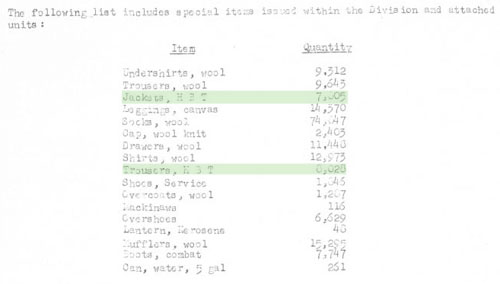
December 1944:
Another month and another river faced the 90th. The rain swollen Saar, Siegfried Line and Germany lay in front of them. As bridgeheads were established across the Saar, the Ardennes Offensive began, effecting Army leadership to pull the back from their tenuous foothold to a more solid defensive footing on the west bank.
After their withdrawal from the east bank, for the period of December 23- January 6, while further defensive preparations were made, the "regiments rotated their battalions in the line enabling all the personnel to share the comforts
of a hot shower and a change to clean clothes"
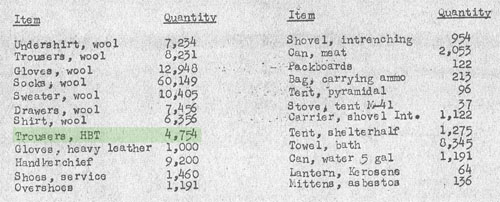
January 1945:
The 90th moved from positions on the Saar to cut off and destroy the German penetration southeast of Bastonge, in the area contained by the 26th Infantry Division, 35th Infantry Division and 6th Armored Division. The 90th played its part in holding and beating back the German Ardennes Offensive.
After the initial commitment to the Battle of the Bulge, battalions at a time, then entire regiments were pulled back one at a time into Division Reserve. While units were in Division reserve, Class II supplies were distributed.
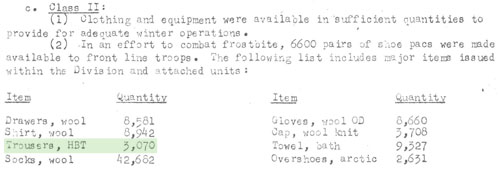

February 1945:
February saw the 90th turn east to the Our river, Germany and the Seigfried line. Initial resistance at the Seigfried line fell quiet by mid month.
March 13 through 18 saw a period of relative quiet along the line, allowing for consolidation, rehabilitation and rotation of troops. During this time, Class II supplies were issued.
The attack was pressed on March 18, with a disintegration of German defenses by the 22nd. The Seigfried line had been breached and a foothold established in the Reich.
G4 Report of operations unavailable.
March 1945:
The end of February and beginning of March was a period of rehabilitation of the 90th in SHAEF reserve after breaking through the Siegfried Line.
March 6, dry clothes and socks were issued.
The 11th Armored Division passed through the 90th's area and
spearheaded the rush to the Rhine river. By March 9, German defenses in the Corps Zone had disintegrated. The 90th advanced quickly behind the 11th Armored, mopping up what little resistance was left.
The 90th was subsequently re-assigned to VII Corps, completing 4 river
crossings during the month. The Kyll, Moselle (for the second time), the Rhine and the Main. The enemy was in full rout.


April 1945:
Teamed with the 4th Armored Division, the 90th followed the advance rounding up German stragglers. "Both Divisions had driven a lancet deep toward the heart of Germany and supply lines stretched far behind them"
April 1 saw "sizable enemy forces had cut across the axis of
communication to the rear, blocked the MSR [Main supply Route] North
of HOCHSTADT and
were harassing and ambushing supply vehicles."
The harassment of supply lines persisted until additional troops could be brought in to secure the flanks, resulting in a temporary slowing of the advance.

Notable events of April 1945:
4/4 Merkers salt mine captured
4/6 Walther factory at Zella Mehlis captured
4/18 entered Czechoslovakia, cutting Germany in two.
4/23 Flossenberg concentration camp liberated
25,000 Prisoners captured
300 miles advanced across Germany into Czechoslovakia
May 1945:
Already into Czechoslovakia and the war's end very apparent, the 90th slowed into a defensive posture. Strong combat patrols were conducted against HitlerJugend and Officer Candidate units in the area.
On May 4, the
11th Panzer Division surrendered en-masse, netting 9,050 prisoners.
Eisenhower's message of May 7 ceased combat operations for the 90th, with patrols being run until contact was made with the Russians on the 10th.
The 90th moved to its initial area of occupation on the 14th.

Summer 1945:
Well into occupation duty the cotton fatigue uniform continued to serve, reverting back to it's stateside role as a work uniform.
Summary:
Of the 11 calendar months that the 90th was engaged in combat for which records are present, Class II Clothing Supply was available in quantity 7 months.
Lets put it all together.
| |
HBT Jacket |
HBT Trousers |
June |
Full Division Issue
|
July |
Full Division Issue |
August |
Class II Supplies Not Available |
September |
Class II Supplies Not Available |
October |
- |
- |
November |
7,605 |
8,028 |
December |
- |
4,754 |
January |
2,490 |
3,070 |
February |
? |
? |
March |
- |
2,733 |
April |
Class II Supplies Not Available |
May |
Class II Supplies Not Available |
| Total |
10,095 |
18,585 |
Conclusion:
My intent writing this is not as a justification to wear HBT's at every event - or to somehow provide ammunition to the "HBT Commandos". This is a cautionary example of how "undead historians" should keep an open mind to usage of uniforms, equipment or weapons. Unlike other time periods, World War II is extraordinarily well documented with many primary sources within easy reach.
Cotton fatigues, with no doubt in my mind were in use continuously as an outermost layer of the uniform by the 90th Division for the entirety of their time in the ETO.
The cotton fatigue components were common at many times, being dominant June and July. Subsequent months saw a mix of uniforms, with the cotton fatigues consistently present in minority ratios.
To say generically that the HBT uniform should be relegated singularly to "Normandy Impressions" is an utter falsehood.
I find it far fetched to believe that the 90th was the only unit in the ETO to receive notable quantities of HBT uniforms. This study should be call to re-examine beliefs held about other units. |



